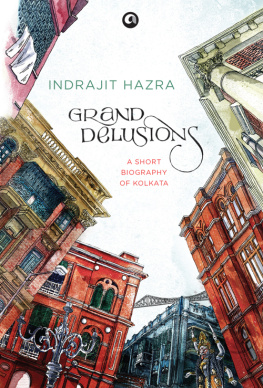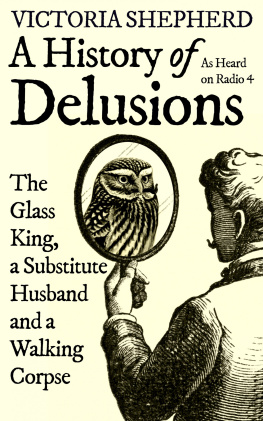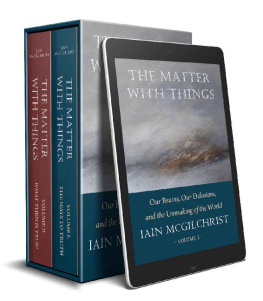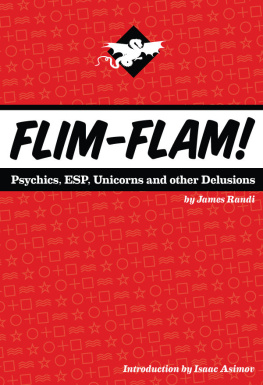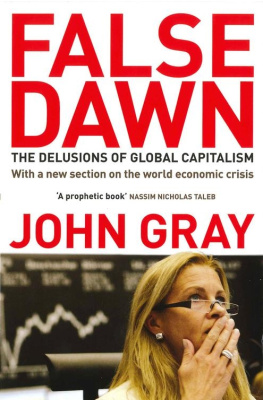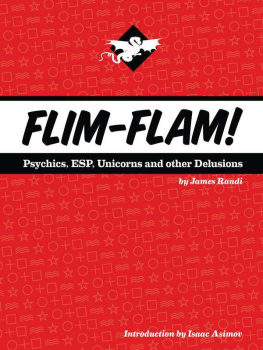About the book
Indrajit Hazras exploration of Kolkataonce Calcutta, headquarters of the Rajgoes far beyond the expected stories about a metropolis that has been mined for its clichs by a long line of writers, artists, grumblers and tellers of tall tales. He takes us to the eccentric paras (neighbourhoods) and clubs of the north and the south; past buildings crumbling silently into spectacular ruins; deep inside Park Streets iconic restaurants and watering holes; through roads choked by political rallies; to rundown cinema halls haunted by lonely men; and into the lairs of soothsayers and tantric love gurus.
Part personal essay, part documentary, part cultural history, Grand Delusions is utterly distinctive and full of surprises. Both intimate and provocative, it shines new light on a great and fascinating city.
As someone whose formative years were spent in Kolkata, I read Indrajit Hazras book with keen interestand delight. He conveys his deep knowledge of Kolkatas history and culture with style and wit, deftly capturing the citys glories and disenchantments, its ironies and its anxieties. The personal and the political are beautifully blended. I thought I knew Kolkata very wellnow, after reading Hazra, I shall visit it afresh with new eyes, and greater understanding. Ramachandra Guha
About the author
Kolkata-born Indrajit Hazra is a novelist and journalist. He was educated at St Xaviers Collegiate School and Jadavpur University. He moved to New Delhi in 1998, where he wrote and published three novels The Burnt Forehead of Max Saul, The Garden of Earthly Delights and The Bioscope Man all set in Kolkata. He also writes the popular Sunday column Red Herring in the Hindustan Times. This is his first book of non-fiction.
Also by Indrajit Hazra
The Bioscope Man (2008)
The Burnt Forehead of Max Saul (2003)
The Garden of Earthly Delights (2000)
ALEPH BOOK COMPANY
An independent publishing firm
promoted by Rupa Publications India
This digital edition published in 2013
First published in India in 2012 by
Aleph Book Company
7/16 Ansari Road, Daryaganj
New Delhi 110 002
Copyright Indrajit Hazra 2013
No part of this publication may be reproduced, transmitted, or stored in a retrieval system, in any form or by any means, whether electronic, mechanical, print reproduction, recording or otherwise, without the prior permission of Aleph Book Company. Any unauthorized distribution of this e-book may be considered a direct infringement of copyright and those responsible may be liable in law accordingly.
e-ISBN: 978-93-83064-60-1
All rights reserved.
This e-book is sold subject to the condition that it shall not, by way of trade or otherwise, be lent, resold, hired out, or otherwise circulated, without the publisher's prior consent, in any form or cover other than that in which it is published.
To
P.203 C.I.T Road
Beleghata
Kolkata
Heads fall off from time to time
Some of them old, some of them young
The conductor hollers into the crowd:
Keep moving forward to the back!
Jam, Sankha Ghosh
O quel cul tas! (What an arse you have!)
Title of a painting by Clovis Trouille on which
the title of the musical Oh! Calcutta is based
CONTENTS
CAVEAT
The sun goes around the Earth once in a year. This line in wobbly English, on old concrete, is accompanied by a text-book sketch that shows a tiny Sun orbiting a giant Earth marked by angles of inclination and the position of the Pole Star. The message relays a fact, not an opinion. There is another statement of fact that comes as a corollary: There is no life on the Mars because Mars is not stationary as the Earth in the space.
The guerrilla graffiti of Kartick Chandra Paul has been around since the mid-1980s, the time I started being a full-fledged observer and participant in that experiment of a city called Kolkata. As a schoolboy, I would encounter the same geocentric message, the same diagram scrawled across walls of houses, colleges, offices, cinemas, sweet-shops and on walls that guarded private plots of wild growth from public streets. This astronomical lesson was a counterpoint to the other, more pervasive variety of graffitipolitical messages, caricatures and cartoons, with the ubiquitous hammer-and-sickle insignia or the hand of the Congress (it still mattered back then). Contrasted with this form of visual hysteria, that would be accompanied by caricatures and cartoons, KC Pauls stern ruminations on a Ptolemaic universe had the air of Truth, so what if it was the wrong Truth.
Pauls scrawls were once everywhere. In the second decade of the twenty-first century, with blue-and-white striped flyovers and giant billboards advertising television reality shows and jewellery, there are far fewer signs to tell us that the Sun revolves round the Earth. The political graffiti has also almost vanished after the government of the time invoked the West Bengal Prevention of Defacement of Property Act in 2006not because of a sudden aesthetic awakening but to ensure that the rising rival political force of a street-fighting lady in chappals would not out-graffiti the ruling party.
But on a wall under the flyover next to Sealdah Station coughing out and sucking in thousands of people, I found one whitewashed wall, turned grimy with dust and piss, which told me, to my bewildered delight, that the quiet heretic KC Paul was still around.
The seventy-three-year-old man from Howrah has now moved more literally to the streets, setting up shop and bed at a busy south Kolkata crossing next to a bus stand. A Class 8 drop out, Paul worked as an apprentice with a car mechanic before joining the Indian Army where, in 1962, he made his discovery. He had even written a letter to NASA, pointing out how Copernicus and company had got it very wrong. NASAs polite letter that the heliocentric theory worked just fine for the world did not deter his belief. There isnt any demand now [for my pamphlets]. But as soon as I am proved correct, people will flock in the thousands to buy them, Paul had told a friend of mine who met him in 1988. In 2012, he told a reporter, All those who ignore me today will have to come back one day and admit that I was telling the truth.
KC Pauls story is joined at the hip with that of the city, which still believes in its utterly special, if no longer central, position in the country it is a part of. Not commerce, not political power, not IT can displace shonshkriti, culture, that most non-material and therefore most lasting of things. And where else is shonshkriti to be found but in the cultural capital of India? If the present governments project is to make Kolkata a second London, this is a more banal version of Kolkatas supreme belief in its cultural superiority through what Schopenhauer termed the Will: a mindless, aimless, non-rational urge at the foundation of instinctual drives and at the foundational being of everything. Through the 80s and 90s, I grew up in a Kolkata that considered itself to be barely part of the hinterland of India, an island of culture and genteelness. Dum Dum Airport connected direct to Heathrow and JFK; Delhi and Bombay were Indian cities out there somewhere.
Such delusions that have held up the city have also been protective for a metropolis in dysfunction and disrepair. The city that Kolkata feeds off to this day was born by the destruction of Bengal. The catastrophic famine between 1769 and 1773 reached its height in 1770, which was when the de facto rulers of the East India Company announced an increase in land tax across the province to make up for its losses. Tax was collected violently and the Company started building a city for its officers and their families. Some ten million people across Bengal died. Food stock was siphoned off to the new city of Kolkata. Towns, including the old capital of Murshidabad, all but shrivelled and died.


